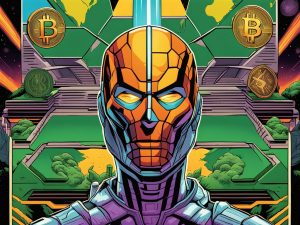The Real Election: Bitcoin vs. USD
In a thought-provoking statement on X (formerly Twitter), Balaji Srinivasan, the former Chief Technology Officer (CTO) at Coinbase and a notable figure in the venture capital world through his tenure at Andreessen Horowitz, stirred the crypto community and beyond with a bold proclamation: “VOTE FOR BITCOIN.” Srinivasan, leveraging his considerable influence in the tech and crypto spheres, articulated a vision that extends beyond mere investment advice, framing the choice between BTC and the US dollar (USD) as a pivotal global referendum.
He argued that the real election is BTC vs USD, highlighting the intrinsic transparency and resistance to manipulation Bitcoin offers compared to traditional financial metrics vulnerable to distortion by central authorities like the Federal Reserve.
Bitcoin Vs. The US-Dollar: The Real Election
Srinivasan’s assertion underscores a growing distrust in the mechanisms of traditional financial regulation and the authenticity of Bitcoin. He further emphasized the significance of recent legal and regulatory developments, particularly pointing to the August 29, 2023, ruling in the Grayscale case as a watershed moment.
He noted that since they can’t fake the price of Bitcoin, the only thing the traditional financial system could do is try to block the exit from dollars to Bitcoin. This is why he believes the SEC fought against ETF access for ten years. However, with the court decision on August 29, 2023, Srinivasan suggests that value can now flow towards the Bitcoin ledger away from centralized control.
The conversation around Bitcoin’s resilience against governmental control is a central theme in Srinivasan’s discourse. He contends that BTC exists on a ledger beyond the federal government’s reach, making it inherently resistant to tactics such as freezing, seizing, inflating, or confiscating assets. This characteristic of Bitcoin not only protects individual wealth but also signals a broader shift in how value is stored and exchanged.
Srinivasan’s insights extend to the investment landscape, where he claims that Bitcoin’s incentives were strong enough to recruit major firms such as BlackRock, Franklin Templeton, and Fidelity. He suggests that absence from the Bitcoin market might soon be seen as a strategic misstep, indicating the growing mainstream acceptance of cryptocurrencies as legitimate assets.
Addressing the broader implications of BTC’s ascendancy, Srinivasan paints a vivid picture of a shifting economic order. He asserts that its vertical rise signals that something is wrong in the legacy economy, telling you that the smart money no longer has full faith and confidence in fiat currencies.
Perhaps most compellingly, Srinivasan delves into the geopolitical and social dimensions of Bitcoin’s rise. He foresees potential conflict as traditional power structures react to the decentralizing force of Bitcoin. He speculates about possible crackdowns on dissent, drawing parallels between historical events and what he perceives as the inevitable backlash against Bitcoin’s disruption of established financial and political norms.
In concluding his thorough exposition, Srinivasan encapsulates the essence of his argument: “So: that’s why BTC vs USD is the real election.” This statement elevates the discourse surrounding BTC from technical and financial considerations to a philosophical and political declaration.
Hot Take: The Future of Finance
Srinivasan’s bold proclamation highlights the growing significance of Bitcoin in global finance. The choice between BTC and traditional fiat currencies like the USD represents more than just an investment decision; it symbolizes a critical juncture in the evolution of global finance and governance.
Bitcoin offers transparency, autonomy, and resistance against centralized control. Its rise signals a shift in market sentiment and reflects broader economic trends and concerns. As the smart money increasingly embraces Bitcoin, it becomes clear that traditional finance is losing its grip on the trust and confidence of investors.
While there may be challenges ahead as Bitcoin disrupts established norms, its resilience and decentralized nature make it an appealing alternative for individuals seeking financial sovereignty. The real election between BTC and USD is not just about which asset to invest in; it’s about choosing a future where transparency, autonomy, and resistance prevail.
So, as you navigate the ever-changing landscape of global finance, consider the implications of Srinivasan’s bold proclamation. The choice between BTC and USD extends beyond investment returns; it represents a vote for a new era of financial freedom.





 By
By
 By
By


 By
By
 By
By